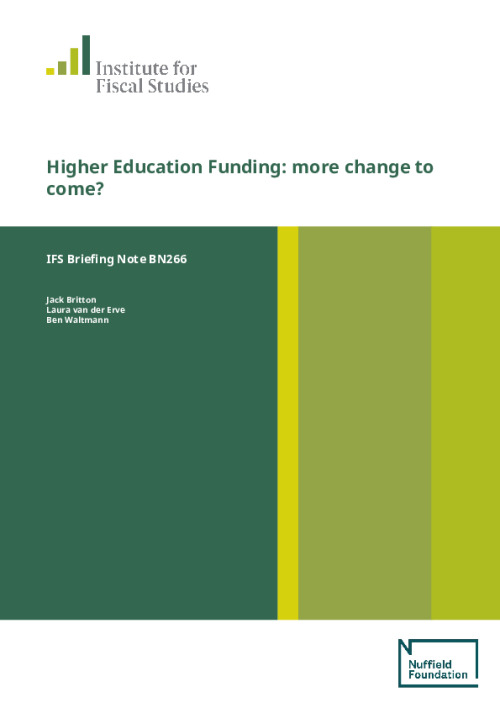This Election Briefing Note provides a summary of the current higher education funding system in England and investigates the two big reform packages that are currently on the table going into the 2019 General Election.
Key findings:
The up-front cost of teaching each cohort of undergraduate students is around £17bn. Most of that money is given out in student loans, which students repay on an income-contingent basis, paying 9% of their income above a certain threshold (currently £25,725). Once graduate loan repayments are accounted for, the cost of providing higher education is roughly evenly split between the government and students, due to the high write-offs on student loans (currently around 45% is expected to be written off). Less than one-fifth of graduates are forecast to repay their student loans in full.
In 2018, the government increased the repayment threshold from £21,000 to £25,000 and froze fees in cash terms at £9,250 per year. Combined, this has dramatically reduced the contribution to higher education from graduates, with middle earning graduates benefitting the most. The impact for government is a substantial increase in the subsidy to HE by about £1.5bn for the 2020 cohort. Universities have experienced a cut in per-student funding, which is set to reach £1800 per degree for the 2020 cohort.
The Labour Party have proposed to abolish fees altogether and to bring back maintenance grants for students from poorer households, which were abolished by the previous government in 2016. Both policies reduce students’ notional debt on graduation but do not affect the cash support they receive during study. In line with a recommendation of the Augar Review, Labour would keep university funding frozen in nominal terms until 2022.
Combined, these policies would increase the long-run taxpayer subsidy by around £6bn per year for full-time undergraduate students, assuming student numbers stay at their current levels. The cost of abolishing fees is around £2bn lower now than we estimated in 2017, mainly because the increase in the repayment threshold means the taxpayer is already contributing more towards the cost of the system.
The highest-earning graduates would benefit the most from Labour’s policy, with loan repayments of the top third being reduced by around £50,000. Low earning graduates would graduate with lower notional debt levels but would be almost completely unaffected in terms of actual loan repayments.
Labour would also extend maintenance support to all part-time students studying for standard undergraduate degrees. Furthermore, its policy of scrapping tuition fees and reintroducing maintenance grants would apply to part-time students and students of higher education qualifications below degree level. Assuming unchanged student numbers, this would add around £500m to the government subsidy for part-time students doing standard undergraduate degrees and another £500m for students pursuing higher education below degree level (or more if Labour decided to extend eligibility beyond those currently eligible for tuition loans).
These estimates of the cost of the policy are likely to be conservative, as the combination of completely free tuition with the current policy of having no cap on student numbers could see student numbers rise further. Bringing back student numbers caps, which were recently removed, could mitigate this problem, but this would likely harm access to university for poorer students.
Under Labour’s plans to support lifelong learning announced last week, free tuition, and maintenance grants and loans, would be available not only for an initial qualification, but for a period of six years, to be used at any point in life. This would increase the opportunities of those who have already obtained a qualification but could lead to a substantial further increase in the taxpayer cost of the higher education funding system and, depending on the details of the policy, increase the risk of fraud.
There are several uncertainties with Labour’s stated policy. Most pertinently, there is the issue of outstanding student debt, which the Labour Party has previously suggested it would “deal with”. Even if only tuition fee debt of post-2012 cohorts were written off, this would cost around £20bn.
The Augar Review – another major reform package potentially on the table - proposed to cut the cap on tuition fees to £7,500, replacing most of the income lost to universities with teaching grants focussed on high cost/high value subjects like engineering. This recommendation was intended to help the government to direct subsidies to where they might be most beneficial economically, rather than to courses where earnings after graduation are lowest as is the case at present.
The Augar Review also proposed to cut loan interest during study and add a cap on the total loan repayments any individual could make. To balance costs, the loan repayment threshold would be reduced again to around £23,000 and the repayment period extended from 30 to 40 years.
The Augar proposals would reduce repayments from higher earning graduates and increase them over the lifetime of lower and middle earning graduates. But the magnitude of these latter increases would be no more than a reversal of the impact of the increase in the repayment threshold implemented by the current government.
The Brexit Party has promised to axe interest rates on student loans altogether. This would cost about £3.5bn, increasing the government contribution to higher education by more than 40%. Again, the highest-earning graduates would benefit the most.
The Liberal Democrats have proposed a £10,000 “adult education grant” which would provide more funding for older learners to re-train. This is similar to Labour’s “six-years free” policy but substantially less generous and only kicks in at age 25. The cost of this scheme, and the risk of fraud, will crucially depend on how tightly it is regulated.
Like Labour, the Liberal Democrats also want to bring back maintenance grants. This would cost around £600 million per year; it would reduce notional student debt on graduation, but leave cash support during study unchanged.
The Green Party’s policy on higher education funding is similar to Labour’s. However, in contrast to Labour, the Green party explicitly advocates the cancellation of all outstanding student debt. This would come at a one-time cost of £70 billion.











